KVT – Cloned Faces at the Art Museum


(Vietnamese version available – Đã có bản tiếng Việt)
KVT attempts to read a lot of things into the work of Nguyen Khac Chinh

A long time ago when I first became acquainted with art in Hanoi I was a bit bewitched by the stylized human figures who had their heads at impossible angles…usually – correct me if I’m wrong – of female figures… as resurrected by artist Nguyen Khac Chinh in an appealing image at his solo exhibition at the Art Museum.

But hanging along side is another equally appealing image of a man with lotus, his impossibly postured head at an opposing angle.

My jet lag addled mind would like to explore the image of a male in feminine posture holding lotus but I’ll keep that for another episode but perhaps suffice to suggest that non masculine depiction of males is becoming socially acceptable in metrosexually tinged media.
Anyway the PR for Nguyen Khac Chinh’s solo was enticing enough to drag me up from a jet lagged stupor and get along to the free gallery at the museum where the two images above demurely greet you as you enter. Demurely being the key word that may have sparks flaring in the eyes of both metrosexuals and other modern young females.

Due to the light headedness that goes along with jet lag, this overview of Chinh’s work is going to be all over the place…but as my favorite animal character in literature, Mehitabel the alley cat so often expounds… ‘What the heck!’ If it encourages a few readers to get along to the museum to see it before the show closes on the 14th then I’ll have done a bit of good.
The artist is on the extreme edge of being able to be described as young (born 1984) but I’ll be kind and put him into that category. His work has been visible around the traps for a while since he graduated from Art University in 2006 and a couple of gallery promos for his earlier work are here and here. And a nice place to start this overview of his present exhibition is this 2011 piece that is a stand out feature in one of the galleries and is for sale at a hefty figure.
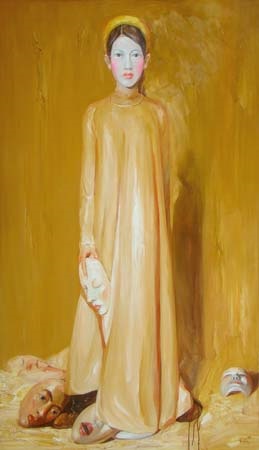
It’s one of the artist’s works that impressed me a while ago with its essence of vulnerability as the young woman goes about the difficult task of wondering what face to present to her world. This confusingly modern world that demands she has a variety of identities as she negotiates the plethora of communication avenues ranging from the intensely personal to the invasive and very public digital arenas of Face book and its spin-offs.
Being a woman she has to negotiate the tricky maze of gender expectations that abound in her particular culture.
The 2013 canvas below appears to place the young female in a dichotomy between traditional gender expectations and a desire or determination to encompass a modern lifestyle….the modern, extra short hair style is open to several interpretations.

In many of the newer canvasses on show the clash between then and now is explored in subtler ways……as in tea and cocktails

and green tea and cigarettes
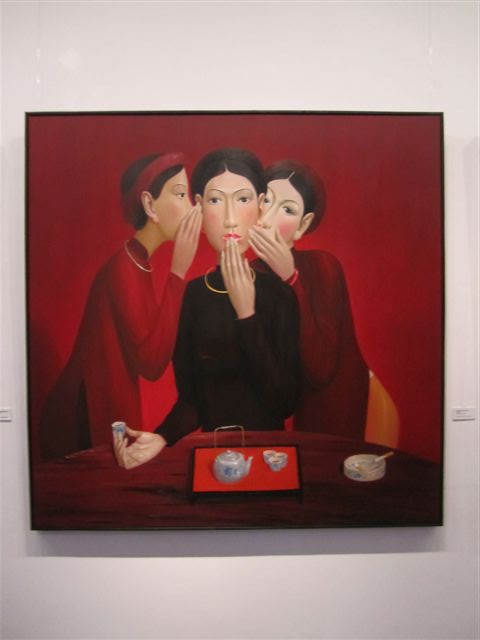
The exhibition is an interesting intersection of Chinh’s work since 2011 and the themes of many females as controllable mannequins in search of identity and socially acceptable visages. The earlier work is more brash and sexy. The later work is traditional and concealing. As you view the pieces you’ll soon notice that all the characters in the little dramas seem to be clones of each other.
One of my favorite pieces features is one that seems to be on the cusp of Chinh’s old and new. The characters represent the gradual movement of urban, northern Vietnamese females from traditional gender constraints and constructs to globalized expectations and new, invented constraints and constructs.
The move from old to new media and communication devices necessarily parallels the above.
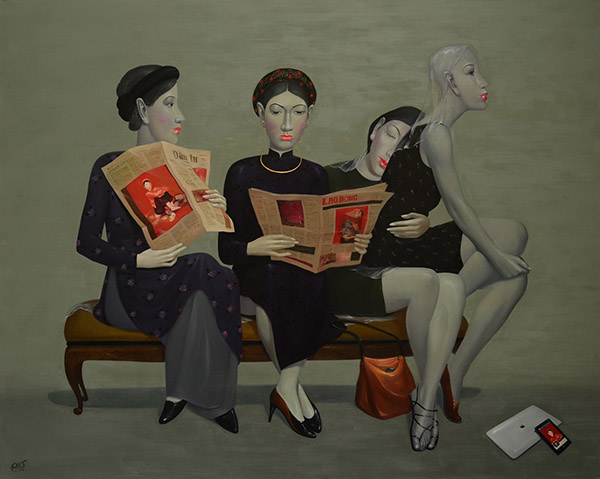
A nice conceit is for the artist to depict one of his initial works in his Faceless series on the cover of a real newspaper….

And by featuring a more controversial image on another- soon to be quaint-newsprint.

While the image on the iphone tells us where it’s all at now…immediately at your fingertips.
Now’s a good time to go back to Chinh’s earlier mannequin canvasses and, for me, the most brash and brassy is this one…again a visual confrontation of traditional and modern expectations and desires.

I like the perspective view of the floorboards which seem to reflect the impossible alignment of floors to subjects in painted portraits of deceased ancestors that sometimes grace household altars …..but I won’t go in that direction in this article!
Two other older works in the show attempt to tie up the cultural and generational pushmepullyous that the artist seems to intimate that today’s local females have to bravely negotiate. Both allude to both sexual and religious mores.
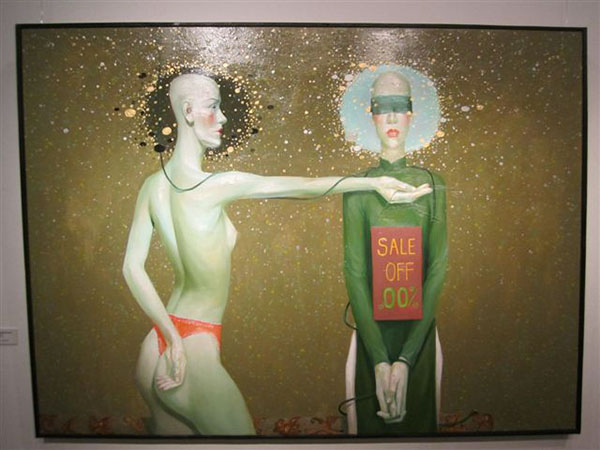
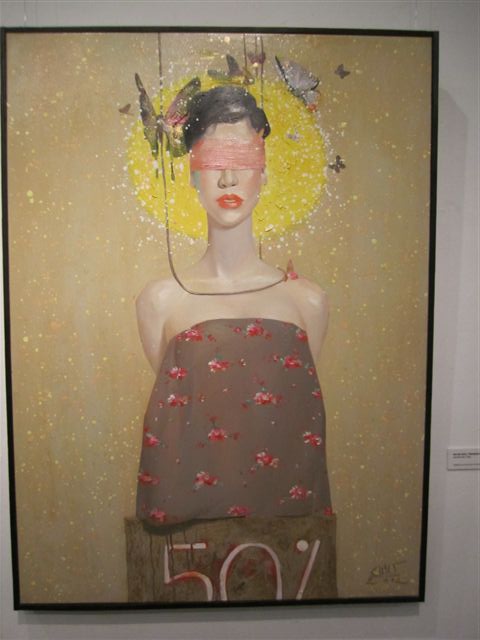
A device used by the artist is the placement of halos on many of his subjects, as circles of light around the figures heads in the older works to the wearing of head bands in traditional representations. I guess this could be taken to represent so many patriarchal religious placements of females as both saint and sexual temptress.
The circlet traditionally worn by younger northern Vietnamese women as a sign of beauty is translated as a khan mo qua which my Vietnamese informants tells me is derived from the bird con qau –the crow or raven. Named after the beak of the bird as explained here.
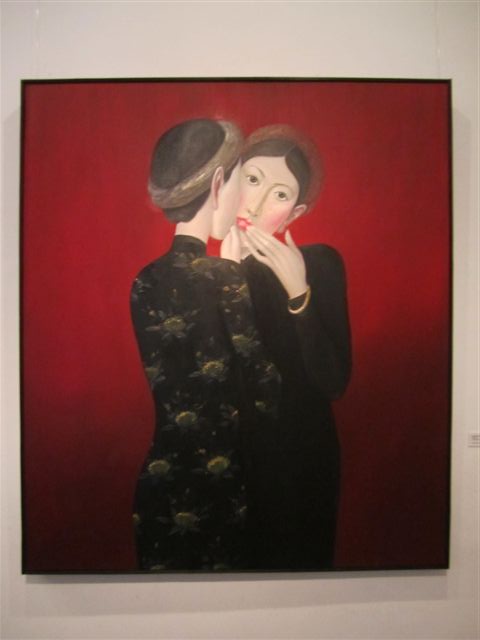
My informants also tell me that the con qua is seen as a good symbol of love and filial gratitude and is a solar symbol, a propitious omen. On the other hand it is a black bird and can also be divined as a sign of foreboding and menacing evil.
A Christian reading has the crow or raven as a symbol of Mary, the mother of Christ and thus of purity and the image below could grace and be revered in any Catholic chapel

as could this more ambiguous, cross cultural meditational pose
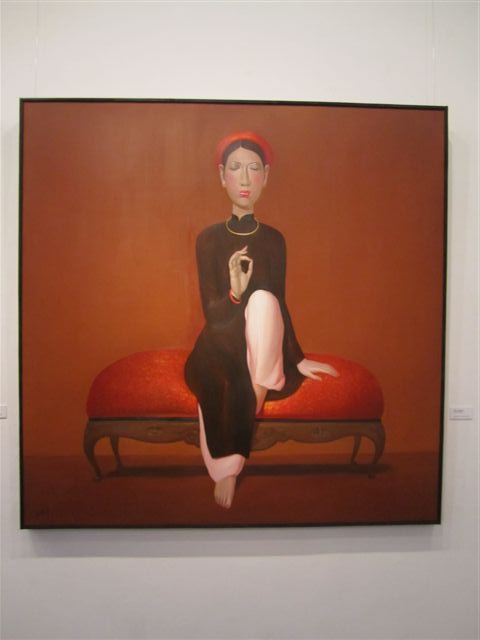
But the bird is also interpreted in their scriptures as a harbinger of sexual temptation to biblical figures.
In English a gathering of crows is a murder of crows. The collective noun for ravens is an unkindness.
After that con qua digression which may or may not have any bearing on the subject of Nguyen Khac Chinh’s paintings, let’s pick up on the word unkindness which can be synonymous with gossip….the beak of the black bird, perhaps also synonymous with unkind cawings. And gossip is another theme running through Chinh’s work….
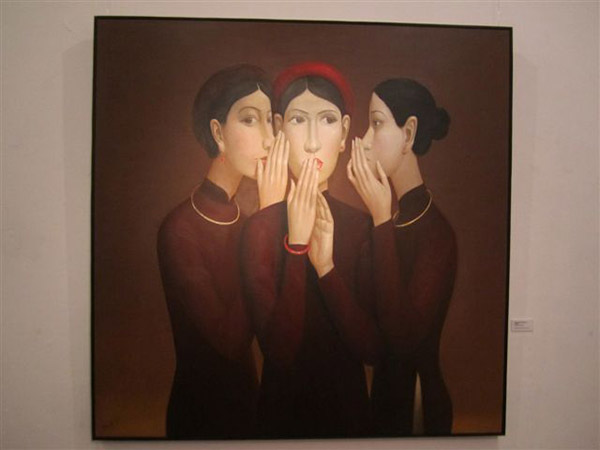
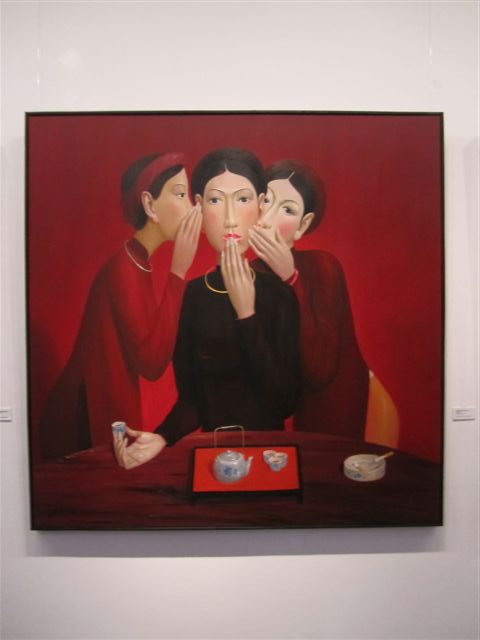
Also running through the artist’s work is the theme of alienation, of wanting to belong…

And the smugness that any teenage girl knows when she is part of the ‘in’ group
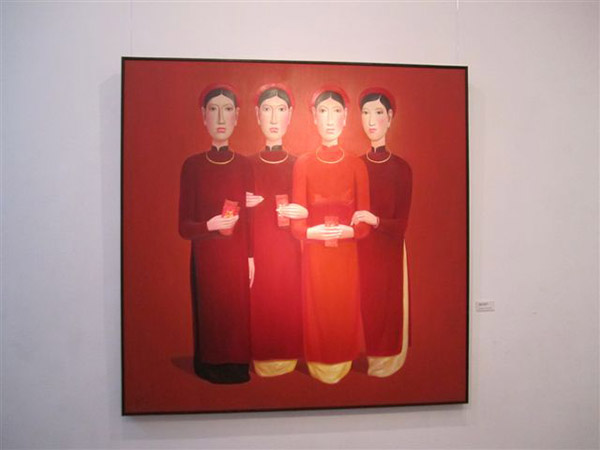
Then there are the recent images of female Ca Tru musicians who, historically played in places to entertain males as I described in a post about a Ca Tru evening with Tri Minh and friends using these words.
‘Had the audience been solely male, we could have imagined ourselves transported back in time to a 17th century inn in Kham Thien Street, near Dong Xuan Market, or Hang Gai, where socially elite males were entertained and where they gave tally cards to the singers to show their appreciation. The cards were exchanged for money. If my research is accurate, in Sino Vietnamese the word ca meant song and tru meant card. Hence the name given to the art form……though its roots went back to the royal courts where musicians played a variety at Ly Dynasty religious court ceremonies (1010-1225). From thence it went on to be royal chamber music and expanded to the homes of the nobility and to the inns previously described.
I found it hard to get hold of an unexpurgated history of Ca Tru music and its predecessors but I’m pretty sure that some torrid historical romantic fiction could be written about the sexual intrigues and affairs that occurred between the top of the range singers and the influential courtiers and mandarins of various dynasties, and, too, the liaisons between lesser talented performers and the males that frequented the noble perimeters in inns of lesser repute.
Top Ca Tru singers were considered to be outside the caste system and so could maneuver within the labyrinths that demarcated social levels and I dare say some played equivalent roles to famous European courtesans who used their talents and their wiles to gain wealth and position…..for like those courtesans, I guess they were easily tossed aside when their looks or various talents faded.’
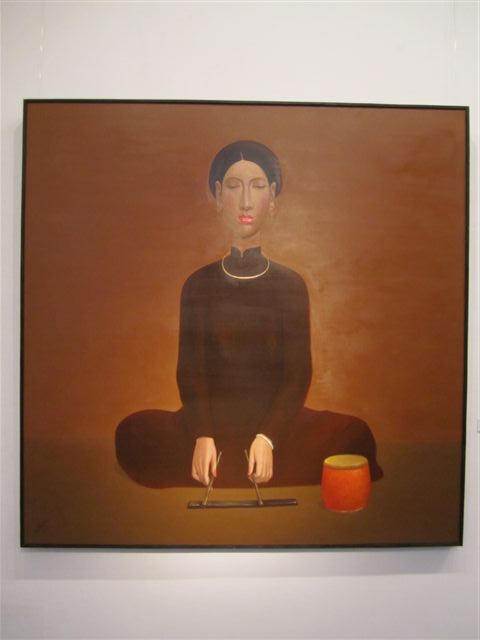
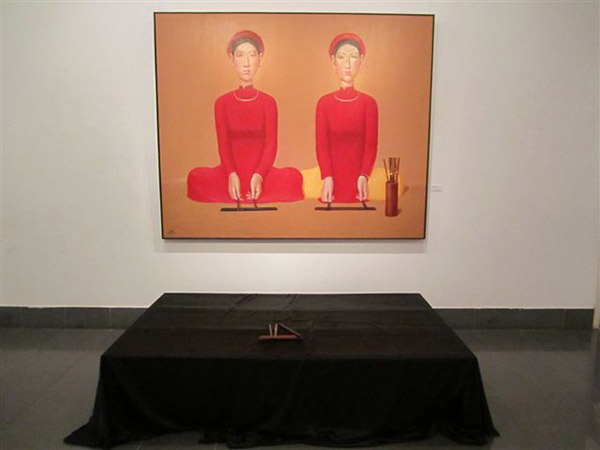
And this is a good enough point to leave the gallery and Chinh’s women before I get up to my neck in hot water with some respected feminists whom I hope will read the paintings differently and use the comment box at the end of the blog to tell us so…

But don’t leave the two galleries until you take special note of the artist’s ability to capture fine details in a super real manner…especially embroidery patterns on fabric
And not before a good look at two canvasses that are either odds with the exhibition’s themes or that encapsulate the underlying tensions
One is a rather beautiful empty highway that leads to an unknown destination or an uncertain adventure…….
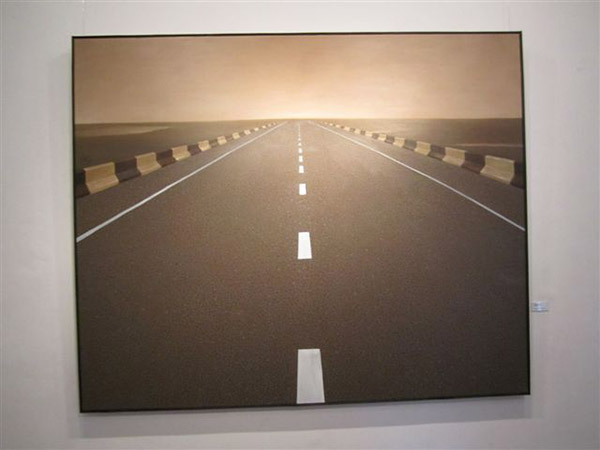
………and that reminds me a lot of the alienation themes inherent in the artistic work of Jeffery Smart.
Another is of a male skipping rope as he meditates a building in the golden distance. Unfortunately my camera skills caught up with my addle headedness at this point and I got a hazy image….an adjective that a lot of readers will attach to this rambling overview

I almost forgot to say that I really liked wandering through the exhibition. It’s a nice exercise to decipher the symbols that the artist knits through his work. I hope I got it a bit right!
| Kiem Van Tim is a keen observer of life in general and the Hanoi cultural scene in particular and offers some of these observations to the Grapevine. KVT insists that these observations and opinion pieces are not critical reviews. Please see our Comment Guidelines / Moderation Policy and add your thoughts in the comment field below. |













